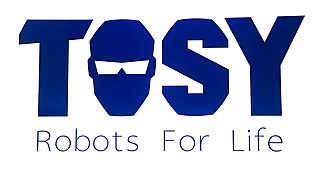
A robot is a machine—especially one programmable by a computer—capable of carrying out a complex series of actions automatically. A robot can be guided by an external control device, or the control may be embedded within. Robots may be constructed to evoke human form, but most robots are task-performing machines, designed with an emphasis on stark functionality, rather than expressive aesthetics.
Telepresence refers to a set of technologies which allow a person to feel as if they were present, to give the appearance or effect of being present via telerobotics, at a place other than their true location.

Telerobotics is the area of robotics concerned with the control of semi-autonomous robots from a distance, chiefly using television, wireless networks or tethered connections. It is a combination of two major subfields, which are teleoperation and telepresence.

Cynthia Breazeal is an American robotics scientist and entrepreneur. She is a former chief scientist and chief experience officer of Jibo, a company she co-founded in 2012 that developed personal assistant robots. Currently, she is a professor of media arts and sciences at the Massachusetts Institute of Technology and the director of the Personal Robots group at the MIT Media Lab. Her most recent work has focused on the theme of living everyday life in the presence of AI, and gradually gaining insight into the long-term impacts of social robots.

A social robot is an autonomous robot that interacts and communicates with humans or other autonomous physical agents by following social behaviors and rules attached to its role. Like other robots, a social robot is physically embodied Some synthetic social agents are designed with a screen to represent the head or 'face' to dynamically communicate with users. In these cases, the status as a social robot depends on the form of the 'body' of the social agent; if the body has and uses some physical motors and sensor abilities, then the system could be considered a robot.
The KHR-1 is a programmable, bipedal humanoid robot introduced in June 2004 by a Japanese company Kondo Kagaku. At the time of its introduction it was one of the least expensive programmable bipedal robots. The robot is 34 cm high and has 17 degrees of freedom. It is capable of a wide range of motions, including quick kung-fu-style fighting moves.
An entertainment robot is, as the name indicates, a robot that is not made for utilitarian use, as in production or domestic services, but for the sole subjective pleasure of the human. It serves, usually the owner or his housemates, guests, or clients. Robotic technologies are applied in many areas of culture and entertainment.

Wakamaru is a Japanese robot made by Mitsubishi Heavy Industries that is intended to perform natural communication with human beings. The yellow, 3-foot domestic robot debuted in 2005 at a $14,300-$15,000 USD price-point exclusively for Japanese households. Through its development, the Wakamaru has been used for presenting at exhibitions, guiding customers, and working as a desk receptionist. However, the Wakamaru has not advanced beyond its first model that was released in 2005.
Robotic pets are artificially intelligent machines that are made to resemble actual pets. While the first robotic pets produced in the late 1990s, were not too advanced, they have since grown technologically. Many now use machine learning, making them much more realistic. Most consumers buy robotic pets with the aim of getting similar companionship that real pets offer, without some of the drawbacks that come with caring for live animals. The pets on the market currently have a wide price range, from the low hundreds into the several thousands of dollars. Multiple studies have been done to show that we treat robotic pets in a similar way as actual pets, despite their obvious differences. However, there is some controversy regarding how ethical using robotic pets is, and whether or not they should be widely adopted in elderly care.
Human–robot interaction (HRI) is the study of interactions between humans and robots. Human–robot interaction is a multidisciplinary field with contributions from human–computer interaction, artificial intelligence, robotics, natural language processing, design, and psychology. A subfield known as physical human–robot interaction (pHRI) has tended to focus on device design to enable people to safely interact with robotic systems.

In Japan, popular robots include humanoid entertainment robots, androids, animal robots, social robots, guard robots, and many more. Each type has a variety of characteristics.

PARO is a therapeutic robot baby harp seal, intended to be very cute and to have a calming effect on and elicit emotional responses in patients of hospitals and nursing homes, similar to animal-assisted therapy except using robots.
Robotics is the branch of technology that deals with the design, construction, operation, structural disposition, manufacture and application of robots. Robotics is related to the sciences of electronics, engineering, mechanics, and software. The word "robot" was introduced to the public by Czech writer Karel Čapek in his play R.U.R., published in 1920. The term "robotics" was coined by Isaac Asimov in his 1941 science fiction short-story "Liar!"
Domestic robots can vary widely in their capabilities and tasks. Sensors include: cliff or stair sensors, motion sensors, ultrasonic object sensors, dirt sensors, IR sensors, and more. Intelligence varies also. Some have none while others can map out their environment and maneuver using complex algorithms.

TOSY Robotics specializes in designing and manufacturing robots and smart toys. The most famous products from TOSY Robotics are TOPIO Robot, DiscoRobo, TOOP and AFO.
The following outline is provided as an overview of and topical guide to robotics:

A domestic robot is a type of service robot, an autonomous robot that is primarily used for household chores, but may also be used for education, entertainment or therapy. While most domestic robots are simplistic, some are connected to Wi-Fi home networks or smart environments and are autonomous to a high degree. There were an estimated 16.3 million service robots in 2018.
RoboSapien is a toy-like biomorphic robot designed by Mark Tilden and produced by WowWee toys. Released in 2004, the Robosapien is preprogrammed with moves, and also can be controlled by an infrared remote control included or by a PDA. The product sold over 1.5 million units between April and December 2004, and was named "Toy of the Year" by the Toy Retailers Association.
Cloud robotics is a field of robotics that attempts to invoke cloud technologies such as cloud computing, cloud storage, and other Internet technologies centered on the benefits of converged infrastructure and shared services for robotics. When connected to the cloud, robots can benefit from the powerful computation, storage, and communication resources of modern data center in the cloud, which can process and share information from various robots or agent. Humans can also delegate tasks to robots remotely through networks. Cloud computing technologies enable robot systems to be endowed with powerful capability whilst reducing costs through cloud technologies. Thus, it is possible to build lightweight, low-cost, smarter robots with an intelligent "brain" in the cloud. The "brain" consists of data center, knowledge base, task planners, deep learning, information processing, environment models, communication support, etc.
Engineered Arts is an English engineering, designer and manufacturer of humanoid robots based in Cornwall, England. It was founded in October 2004 by Will Jackson.









